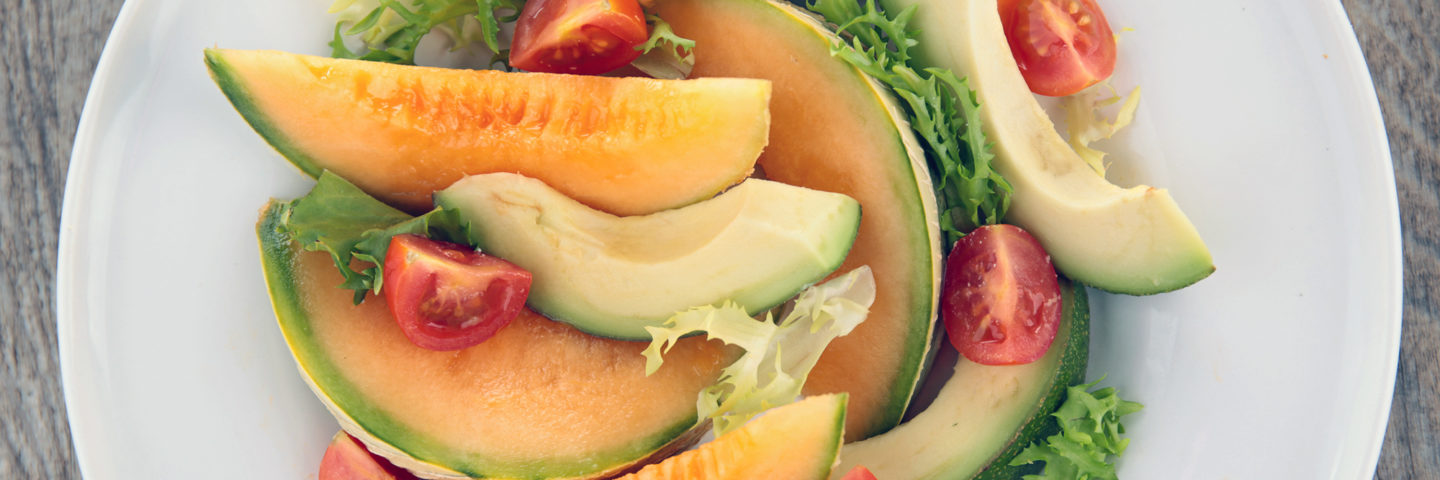
Seasonal Summer Sensations For Your Next Small Gathering
Craving Cantaloupe
Summer traditionally brings us a bounty of fresh fruits and vegetables. One of my favorites is cantaloupe. Cantaloupe is in season in the U.S. from May through November so right now they are at the peak of availability. When I was growing up, I always looked forward to the arrival of cantaloupe in the spring. My mother would slice it in wedges and place it in a in a bowl in the refrigerator to enjoy as a sweet, crisp, delectable snack or dessert on a hot summer day.
Nutritious
A one-cup serving of cantaloupe delivers a whopping 29% of the daily value for vitamin A and 64% for vitamin C. These nutrients are involved in promoting healthy eyes, skin, teeth and gums, protecting against infections, helping heal cuts and wounds and supporting a strong immune system. Cantaloupe also supplies fiber, potassium, magnesium, vitamins B6, folate, niacin and thiamin as well as lutein and zeaxanthin, important nutrients for eye health.
Delicious
Not only nutritious but also delicious, cantaloupe is a great addition to any meal or snack. Cool and refreshing, it can be mixed with yogurt and cereal at breakfast, eaten as a dessert for lunch, wrapped with lean ham for a snack or tossed with veggies at dinner like this Garden Fresh Cantaloupe Cucumber Salad from the California Cantaloupe Board.
Safe
The California Cantaloupe farmers are committed to producing safe, high-quality melons for consumers. They are grown under a mandatory food safety program with government auditors inspecting all aspects of cantaloupe production.
And safety doesn’t stop at the farm. Once your cantaloupe is in your kitchen, be sure to wash the melon before cutting and eating. Rinse it well under running water and use a brush to remove soil and bacteria that may be stuck in crevices. By washing before cutting, you’ll avoid introducing bacteria into the edible part of the fruit when you cut through the melon with a knife.
Tasting Tomatoes
Another of my summer favorites is tomatoes. As a child I ate fresh tomatoes from my grandmother’s garden. Nothing is better than a ripe tomato fresh from the vine. But it’s sometimes difficult to find a really tasty tomato because they’re often picked before they reach their full ripeness – and flavor – to make sure they’re still fresh after traveling across the country.
Convenient
Of course, canned tomatoes offer the flavor and nutritional value of fresh tomatoes all year-round. I had the opportunity to visit a California tomato farm during harvest and followed the truck of freshly picked tomatoes to the cannery down the road to tour the plant. The tomatoes were in the can in less than five hours from harvest, at the height of their flavor, ripeness and nutrition. Studies actually show that canned foods provide as much – and sometimes even more – nutritional value as fresh ones do.
Healthy
Tomatoes are also a nutrition powerhouse, contributing healthy doses of potassium, iron, magnesium vitamin C, thiamin, niacin, riboflavin and fiber. Tomato’s superstar nutrient is lycopene, with 80% of the lycopene in the American diet found in tomatoes and tomato products. Lycopene is two to ten times higher in canned tomato products like soup, sauce, juice, puree and paste vs. fresh because much of the water has been removed, thus concentrating the nutrient. Plus cooking tomatoes makes lycopene more available to the body.
Versatile
Canned tomatoes are so versatile to use in dishes ranging from pasta, pizza, soups and stews to stir fries, omelets, salsa and salads. One of my favorites is the tri-color salad-ready canned tomatoes packed in water, olive oil and Italian spices with a firm texture that is perfect for salads. They’re packed by Pacific Coast Producers for store brands across the country.
If you’re looking for another simple and refreshing summer dish, try this cold Easy Gazpacho from Tomato Wellness. It’s made with canned, diced tomatoes and should just hit the spot.


